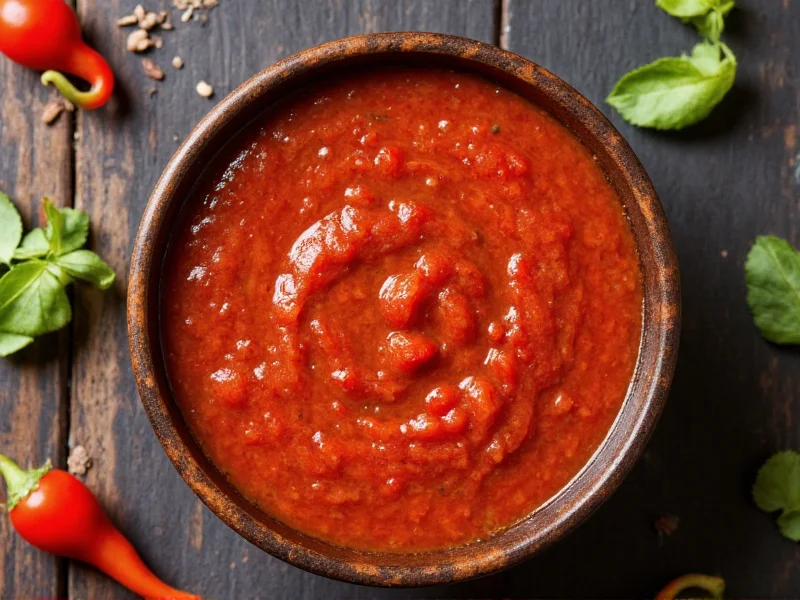Understanding salsa heat levels helps consumers make informed choices whether shopping at grocery stores or ordering at Mexican restaurants. The distinction between mild and medium salsa primarily comes down to the type and quantity of peppers used in the recipe.
How Salsa Heat Levels Are Determined
Salsa spiciness depends on several key factors that manufacturers and chefs control to create consistent heat levels:
- Pepper selection - Mild salsa typically uses only bell peppers or no peppers at all, while medium salsa incorporates jalapeños with some seeds and membranes removed
- Seed and membrane content - The white pith and seeds contain most of the capsaicin (the compound that creates heat), so medium salsa includes more of these elements than mild
- Pepper preparation - Chefs may roast jalapeños for medium salsa to mellow the heat slightly while maintaining flavor complexity
- Additional ingredients - Tomatoes, onions, and cilantro can balance heat perception, making medium salsa more approachable than its actual Scoville rating might suggest
Mild vs Medium Salsa: Key Differences
| Characteristic | Mild Salsa | Medium Salsa |
|---|---|---|
| Heat level (Scoville) | 0-500 units | 1,000-5,000 units |
| Primary peppers | Bell peppers, no peppers | Jalapeños (partially deseeded) |
| Heat sensation | None to barely noticeable | Noticeable warmth, mild burn |
| Best for | Children, heat-sensitive individuals | Most adults seeking flavor with some kick |
| Flavor profile | Fresh, tomato-forward | Complex with subtle heat undertones |
Why Medium Salsa Packs More Heat
The consistent difference between mild and medium salsa comes from intentional recipe design. Manufacturers create mild salsa specifically for those who prefer no heat, often eliminating spicy peppers entirely. Medium salsa represents the entry point for consumers who want authentic salsa flavor with a noticeable but not overwhelming heat level.
When comparing is medium salsa hotter than mild, the answer remains consistent across major brands like Pace, Tostitos, and restaurant-style preparations. Medium salsa typically contains about 2-5 times more capsaicin than mild varieties, creating that distinctive warming sensation without causing significant discomfort for most people.
Choosing Between Mild and Medium Salsa
Selecting the right salsa heat level depends on your personal tolerance and intended use:
- For dipping with children - Stick with mild salsa to ensure everyone can enjoy the experience
- With delicate dishes - Mild salsa complements fish tacos or egg dishes without overpowering them
- For authentic flavor experience - Medium salsa provides the traditional balance of heat and flavor expected in Mexican cuisine
- If unsure about your heat tolerance - Start with medium salsa before moving to hot varieties
Understanding the difference between mild and medium salsa helps prevent unpleasant surprises when shopping or dining out. Most grocery stores now clearly label heat levels, and restaurants often describe their salsa offerings to help customers choose appropriately.
Practical Tips for Salsa Selection
When deciding between mild and medium salsa options, consider these practical tips:
- Check ingredient lists for "jalapeño" mentions - their presence usually indicates medium or hotter varieties
- Look for visual cues - medium salsa often has small flecks of green from jalapeños
- Ask restaurant staff about their salsa heat scale explained for that establishment
- Start with medium salsa if you enjoy black pepper or spicy mustards
- Remember that freshness affects heat perception - refrigerated salsa often tastes spicier than shelf-stable varieties
Common Questions About Salsa Heat Levels
Is medium salsa always spicier than mild salsa?
Yes, medium salsa is consistently spicier than mild salsa across commercial brands and restaurant preparations. This standard heat progression follows industry conventions where mild salsa contains minimal to no spicy peppers, while medium salsa incorporates a noticeable but manageable level of heat from jalapeños or similar peppers.
What makes medium salsa spicier than mild?
Medium salsa contains jalapeño peppers with some seeds and membranes (which contain capsaicin, the compound that creates heat), while mild salsa typically uses only bell peppers or no peppers at all. The additional capsaicin content in medium salsa creates its characteristic warmth without being overwhelming.
How much hotter is medium salsa compared to mild?
Medium salsa typically registers between 1,000-5,000 Scoville Heat Units, while mild salsa measures 0-500 units. This means medium salsa is generally 2-5 times hotter than mild varieties, though individual tolerance varies significantly.
Can mild salsa ever be spicier than medium?
No, this would violate industry standards. If a product labeled "mild" is spicier than one labeled "medium," it represents either mislabeling or an extremely unusual preparation that doesn't follow standard salsa heat conventions. Consistent labeling helps consumers make informed choices.
Why do restaurants sometimes have different heat levels?
Restaurant salsa heat can vary based on chef preferences, regional traditions, and fresh ingredient availability. While the "medium is spicier than mild" principle holds true, the actual heat level of "medium" at one restaurant might equal "hot" at another. Always ask about their specific heat scale when dining out.











 浙公网安备
33010002000092号
浙公网安备
33010002000092号 浙B2-20120091-4
浙B2-20120091-4